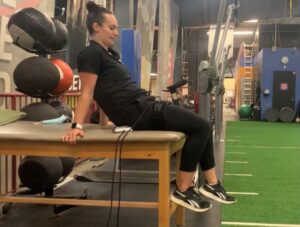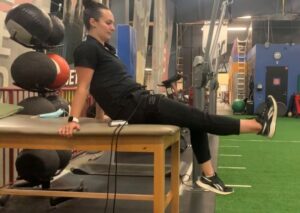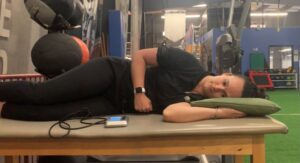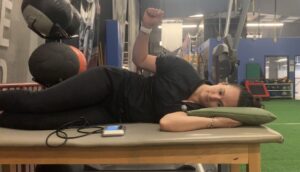What is Blood Flow Restriction (BFR) training?
Here at Elite, we’re always striving to keep up with the latest research in physical therapy, strength and conditioning, and sports performance to ensure that we’re offering our patients and clients the most effective and evidence-based treatments and training modalities available. We’re not interested in keeping up with the latest fitness fads, but instead, offering our patients and clients proven, science-based interventions to optimize their recovery, results and performance. With that in mind, we offer BFR (Blood Flow Restriction) training at our facilities. In this month’s blog post, we provide additional background information on the background and benefits of this intervention.
What is Blood Flow Restriction Training (BFR)?
BFR has become increasingly popular within the Physical Therapy, Athletic Training, and Strength and Conditioning communities over the past several years as more research has emerged supporting its benefits. BFR uses specialized blood flow restriction cuffs to occlude the venous outflow of blood from a limb and partially occlude arterial blood flow into a limb with the goal of improving muscle hypertrophy and strength gains. BFR can be used not only with low load resistance training but also with aerobic training and even at rest to promote muscle hypertrophy and strength. It is especially effective for improving muscle strength and function when high training loads cannot be used (i.e. when rehabilitating from an injury).
How does BFR work?
Two methods of building muscle hypertrophy and strength have been studied and accepted by strength and conditioning and rehab professionals. The first is to mechanically load a muscle at or greater than 70% of that person’s 1RM (1 Repetition Max) and the second is to mechanically load a muscle at lower loads (30-50%) of that person’s 1RM until failure. Although mechanical stress is a major factor in building hypertrophy, with BFR it is only an additive effect and not the primary mechanism. BFR is theorized to work primarily through pathways that rely on metabolic stress including muscle cell swelling because of metabolite induced fatigue. Because there is no venous outflow, lactic acid and other muscle byproducts accumulate in the limb which act as primary moderators for an anabolic (muscle-building) response. This accumulation leads to muscle cell swelling which promotes an enzyme response for muscular anabolic and catabolic processes and increased muscle fiber recruitment.


Who is BFR most appropriate for?
Blood flow restriction training should be used with the goal of muscle hypertrophy and strength in populations that are load compromised (cannot tolerate heavy loading of exercises) including but not limited to: post-operative, elderly and older active adults, and people with high pain levels. The research does not support the use of BFR over a progressively loaded strengthening program at or above 70% 1RM, which therefore makes it most appropriate for the rehab setting.
What are the guidelines for optimizing BFR?
Arguably the most important piece of BFR is what pressure range to use and how much to load people. For the safest and most effective outcomes:
- Lower extremity: 60-80% limb occlusion pressure (LOP)
- Upper extremity: 40-50% limb occlusion pressure
- Resistance: 20-40% 1RM
- Volume: 30 x 15 x 15 x 15
- Frequency: 2-3x/wk is superior to 4-5d/wk because of an overtraining effect
Because of fluctuations in blood pressure throughout the week, fluid intake, sodium intake and fluctuations in blood pressure throughout the day, it is recommended to assess LOP every time one performs BFR. Using higher pressures (70-80% LOP) may result in increased discomfort, muscle pain and cardiovascular stress but are more beneficial for analgesic effects than lower pressures. Consider using higher LOP’s and lower loads (20-30% 1RM) for people who have higher levels of pain. When giving people with higher loads (30-50% 1RM), consider using lower limb occlusion pressures (40-60% LOP) for improved tolerance to exercising with BFR.
Generally, we should expect to see significant changes in muscle hypertrophy around 2-4 weeks and improved strength between 4-6 weeks if the person is being loaded appropriately.


Contraindications and Precautions
BFR is found to be a very safe treatment but is known to have mild side effects including bruising and transient numbness that occur with the initiation of BFR training and dissipate as the person continues to use it.
Contraindications:
- History of DVT
- Pregnancy
- Varicose veins
- High blood pressure
- Cardiac disease
- Rhabdomyolysis
Precautions:
- Subcutaneous hemorrhage
- Numbness
- DOMS (Delayed Onset Muscle Soreness)
- Feeling cold
Are you in need of Physical Therapy, Occupational Therapy, or injury rehabilitation services? We’re here to help! Elite Sports Performance & Physical Therapy in Stoughton and Foxboro offer a highly-trained and experienced PT staff who are ready to help you with your recovery and getting you back to doing the things you love! Give us a call today at 781-436-0391 (Stoughton) or email us at PTinfo@EliteFitCenter.com. For Foxboro, call us at 774-332-1723 or email us at info@EliteSportsandPT.com!
References
- Vanwye W, WEATHERHOLT A, MIKESKY A. Blood Flow Restriction Training: Implementation into Clinical Practice. International Journal of Exercise Science. 2017;10(5):649-654
- Hughes L, Paton B, Rosenblatt B, Gissane C, Patterson SD. Blood flow restriction training in clinical musculoskeletal rehabilitation: a systematic review and meta-analysis. British Journal of Sports Medicine. 2017;51(13):1003-1011. doi:10.1136/bjsports-2016-097071.
- Scott BR, Loenneke JP, Slattery KM, Dascombe BJ. Exercise with Blood Flow Restriction: An Updated Evidence-Based Approach for Enhanced Muscular Development. Sports Medicine. 2014;45(3):313-325. doi:10.1007/s40279-014-0288-1.
- Dankel SJ, Jessee MB, Abe T, Loenneke JP. The Effects of Blood Flow Restriction on Upper-Body Musculature Located Distal and Proximal to Applied Pressure. Sports Medicine. 2015;46(1):23-33. doi:10.1007/s40279-015-0407-7.
- Korakakis V, Whiteley R, Giakas G. Low load resistance training with blood flow restriction decreases anterior knee pain more than resistance training alone. A pilot randomised controlled trial. Physical Therapy in Sport. 2018;34:121-128. doi:10.1016/j.ptsp.2018.09.007.
- Jessee MB, Mattocks KT, Buckner SL, et al. Mechanisms of Blood Flow Restriction: The New Testament . Techniques in Orthopaedics. 2018;33(2):72-79. doi:10.1097/bto.0000000000000252.
